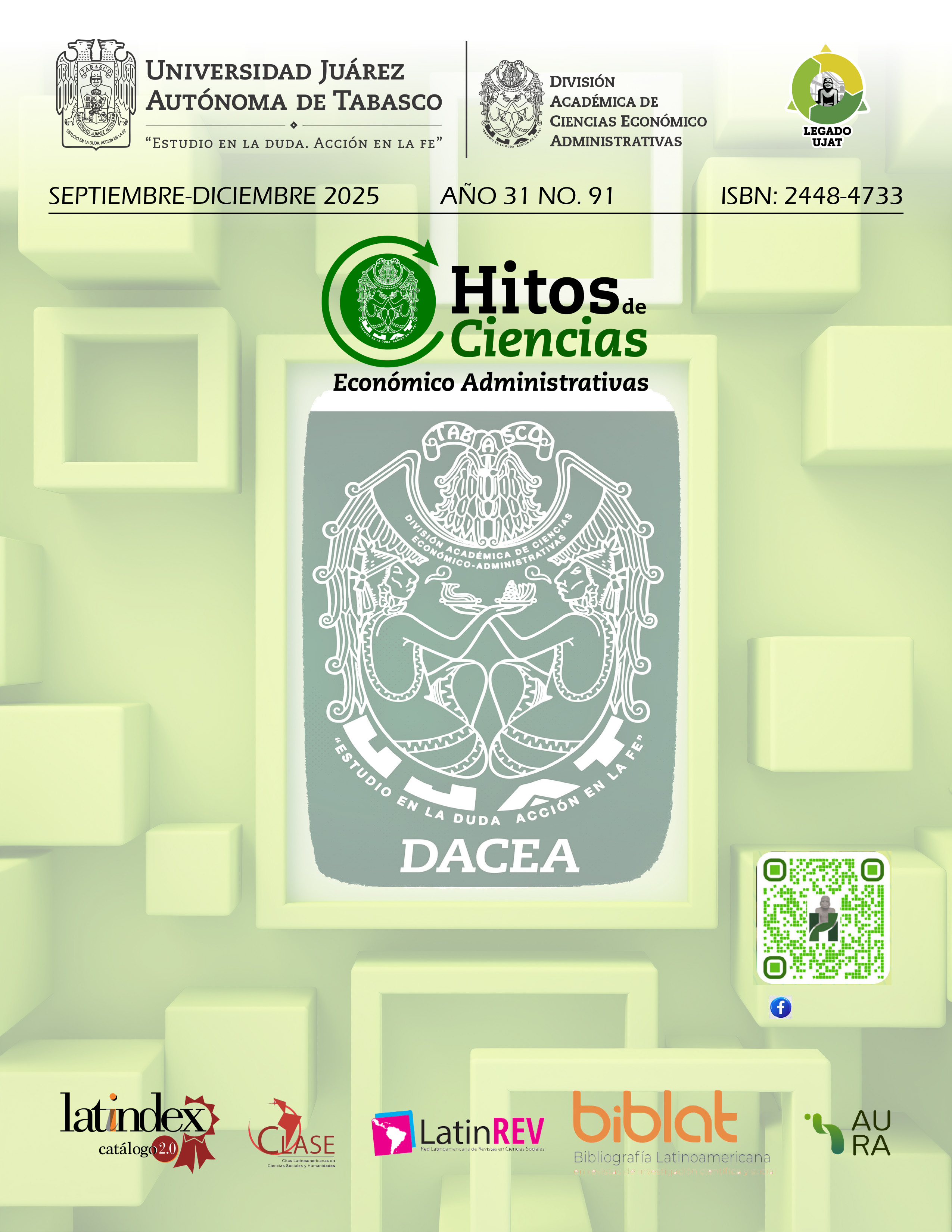Student perceptions of learning management at the Faculty of Accounting and Administration at UACH
DOI:
https://doi.org/10.19136/hitos.a31n91.6347Keywords:
perception, management, teaching, infrastructure, student satisfaction.Abstract
OBJECTIVE: To analyze students’ perceptions from the Faculty of Accounting and Administration at Universidad Autónoma de Chihuaha [UACH] regarding the management of learning delivery.
MATERIAL AND METHOD: A descriptive and cross-sectional research study was conducted in 2024, based on a mixed approach with a hypothetical-deductive method. To collect data, a survey was administered to 148 students, designed to investigate demographic aspects, as well as perceptions regarding educational administration, teaching staff, infrastructure, and resources. The sample was calculated with a confidence level of 86% and a margin of error of 6%.
RESULTS: 54.1% of students rated the educational administration as “good”, while 64.9% considered the administrative staff accessible. Regarding the teaching staff, 48.6% rated them as “good”,, and 54.7% perceived them as “available” outside the lesson hours. The infrastructure was rated as “good” by 45.9%, and the technological facilities as “adequate” by 43.2%.
CONCLUSIONS: Student perception reflects general satisfaction with educational administration, although areas for improvement remain, especially in administrative accessibility and technological resources.
Downloads
References
Bélanger, C., Longden, B. y Orozco, E. P. (2019). How Mexican students perceive their classroom experience from their professors. Tertiary Education and Management, 25(2), 161–180. https://doi.org/10.1007/s11233-019-09019-y
Bracho, T. (2003). Administración centrada en la escuela. https://repositorio-digital.cide.edu/handle/11651/5247
Cano, E. (2008). La evaluación por competencias en la educación superior. Narcea. Profesorado, Revista de Currículum y Formación del Profesorado, 12(3), 16. https://revistaseug.ugr.es/index.php/profesorado/article/view/20503
Canchaya, E. M. (2021). Gestión educacional en Latinoamérica: revisión de marcos teóricos y prácticas emergentes. Revista Educarnos, 14(2), 147–156. https://revistaeducarnos.com/wp-content/uploads/2021/07/edelmira.pdf
CIEES. (2024). Marco específico para la evaluación de programas educativos de TSU y licenciatura en modalidad escolarizada. https://www.ciees.edu.mx/documentos/MGE2024/anexos/Marco%20especifico%20TSU%20y%20licenciatura%20escolarizada.pdf?utm_source
Cuesta, A., Glewwe, P. y Krause, B. (2016). School infrastructure and educational outcomes: A literature review, with special reference to Latin America. Economía LACEA Journal, 17(1), 95–130. https://doi.org/10.31389/eco.47
Fredricks, J. A., Blumenfeld, P. C. y Paris, A. H. (2004). School engagement: Potential of the concept, state of the evidence. Review of Educational Research, 74(1), 59–109. https://doi.org/10.3102/00346543074001059
Garbanzo, G. (2014). Factors associated with academic performance including socioeconomic level: A multiple regression study of university students. Revista Electrónica Educare, 18(1), 119-154. https://www.revistas.una.ac.cr/index.php/EDUCARE/article/view/5566
González‑Peiteado, M. Á., Pino‑Juste, M. y Penado‑Abilleira, M. (2016). Valoración psicométrica de un cuestionario para medir la satisfacción con la experiencia universitaria. Revista Iberoamericana de Educación a Distancia, 19(1), 243–260. https://www.redalyc.org/articulo.oa?id=331450972013
Harvey, L. y Green, D. (1993). Defining quality. Assessment & Evaluation in Higher Education, 18(1), 9–34. https://doi.org/10.1080/0260293930180102
Hurtado‑Vargas, C. (2023). Percepción de la calidad del servicio educativo en estudiantes universitarios de Lima. Revista Científica UPSC, 16(3), 45–59. https://repositorio.upch.edu.pe/bitstream/handle/20.500.12866/16306/Percepcion_HurtadoVargas_Cynthia.pdf?sequence=1
Kahu, E. R. (2013). Framing student engagement in higher education. Studies in Higher Education, 38(5), 758–773. https://doi.org/10.1080/03075079.2011.598505
Mejía-Rodríguez, D. L. y Mejía-Leguía, E. J. (2021). Evaluación y calidad educativa: Avances, limitaciones y retos actuales. Revista Electrónica Educare, 25(3), 702–715. https://doi.org/10.15359/ree.25-3.38
Montenegro, J. (2020). La calidad en la docencia universitaria. Una aproximación desde la percepción de los estudiantes. Educación, 29(56), 116-145. https://doi.org/10.18800/educacion.202001.006
Murillo, F. J. (2018). Dirección Escolar: Factor Clave de Eficacia y de Cambio. REICE. Revista Iberoamericana Sobre Calidad, Eficacia y Cambio en Educación, 4(4). https://revistas.uam.es/reice/article/view/10088
Olesova, L., Yang, D. y Richardson, J. C. (2015). Cross‑Cultural Differences in Undergraduate Students’ Perceptions of Online Barriers. Journal of Asynchronous Learning Networks, 15(3), 68–79. https://files.eric.ed.gov/fulltext/EJ935586.pdf
Parasuraman, A., Zeithaml, V. A. y Berry, L. L. (1988). SERVQUAL: A multiple-item scale for measuring consumer perceptions of service quality. Journal of Retailing, 64(1), 12–40. https://www.researchgate.net/publication/225083802_SERVQUAL_A_Multiple-Item_Scale_for_Measuring_Consumer_Perceptions_of_Service_Quality
Patiño, D. A. (2024). Impacto de las tecnologías de la información y comunicación en la educación: estado actual de docentes y estudiantes. LATAM Revista Latinoamericana de Ciencias Sociales y Humanidades, 5(2), 1004–1021. https://doi.org/10.56712/latam.v5i2.1931
Poquioma Woo, M. A., Saldaña Poquioma, K. D. J., Barrenechea Moreno, H. G. y Prado Lozano, P. (2021). Gestión de la calidad en la educación superior: una revisión sistemática. IGOBERNANZA, 4(1), 334–356. https://doi.org/10.47865/igob.vol4.2021.160
Tam, M. (2001). Measuring quality and performance in higher education. Quality in Higher Education, 7(1), 47–54. https://doi.org/10.1080/13538320120045076
Tinto, V. (1997). Classrooms as communities: Exploring the educational character of student persistence. The Journal of Higher Education, 68(6), 599–623. https://doi.org/10.1080/00221546.1997.11779003
World Bank. (2016). World Development Report 2016: Digital Dividends. World Bank. https://doi.org/10.1596/978-1-4648-0671-1 (worldbank.org)
Yorke, M. (2003). Formative assessment in higher education: Moves towards theory and the enhancement of pedagogic practice. Higher Education, 45(4), 477–501. https://doi.org/10.1023/A:1023967026413
Downloads
Published
Issue
Section
License
Copyright (c) 2025 HITOS DE CIENCIAS ECONÓMICO ADMINISTRATIVAS

This work is licensed under a Creative Commons Attribution-NonCommercial-NoDerivatives 4.0 International License.
As a requirement for the manuscript, the author is requested to provide the Copyright Assignment Letter, so that the Journal has the publication rights and to avoid plagiarism.
PLAGIARISM POLICIES
The Editorial Board of the Journal HITOS DE CIENCIAS ECONÓMICO ADMINISTRAIVAS has the authority to reject in the review process any manuscript that does not have adequate citation in the documents consulted in its scientific research work, which can be considered as plagiarism behaviors. Likewise, the referees carry out the plagiarism review using specialized software, such as iThenticate, among others.
COPYRIGHT POLICIES
Authors who have publications in the journal accept the following terms: • At the time the manuscript is accepted, the author transfers the copyright to the Journal HITOS DE CIENCIAS ECONÓMICO ADMINISTRATIVAS.
- The authors may make additional agreements for non-exclusive distribution of the published version of the article (e.g., including it in an institutional repository or publishing it in a book) provided that the initial publication in this journal is indicated.
- Authors are allowed and recommended to publish their research work on the Internet (eg, institutional or personal files), which would allow more beneficial exchanges to increase the citation of the published work.
This work is licensed under Creative Commons Attribution-NonCommercial-NoDerivatives 4.0 International

